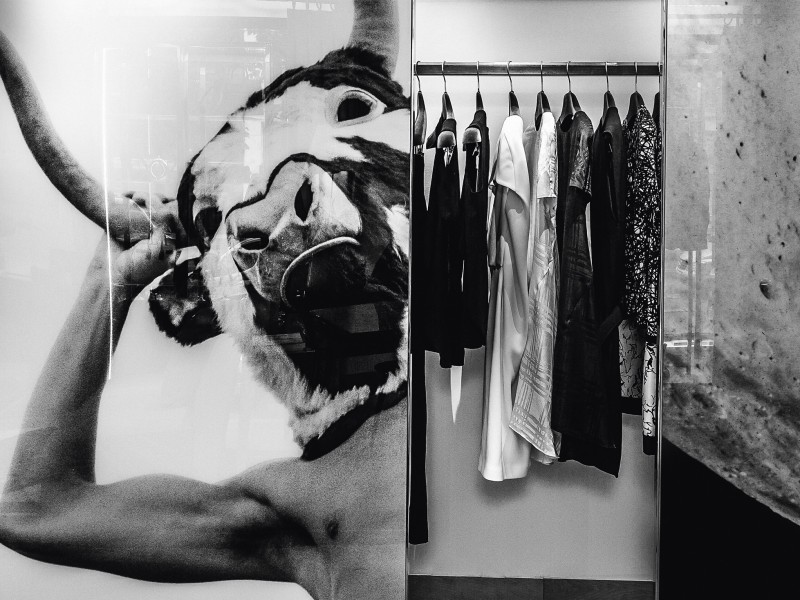Crisis hit the Sackett–Wilhelms Lithographing and Publishing Company in 1902. The printers couldn’t get their colours to align properly on the page, the result of too much heat and humidity in their East Williamsburg printing plant. Worst of all, the ink refused to dry.
Willis Carrier, an apprentice engineer from the Buffalo Forge Company, came up with a solution. By jury rigging a contraption out of fans, ducts, heaters and perforated pipes, he managed to bring the temperature and humidity in the factory down to an acceptable level. It was the first known instance of modern air conditioning. The colours started to align properly—and, finally, the ink dried. More than 100 years later, in 2008, Tony Garifalakis was in that very same building, willing his paint not to dry, at least not completely.
The Australian artist was on a residency in New York with the International Studio & Curatorial Program, a nonprofit contemporary art institution that had just moved into the site of the former factory that year.
Splayed across the desk in Garifalakis’s studio space was a pile of glossy gossip magazines, the kinds you’d find at supermarkets. At the forefront of his mind, however, was something far from the flashy and sordid goings-on of celebrities or celebrity wannabes. He was thinking about declassified FBI files. More specifically, he was thinking about the black redaction marks and the way they crawled across the text of sensitive documents like caterpillars, chewing away at words deemed inappropriate for the public eye.
With a can of black enamel spray paint in his hand, Garifalakis turned to the glossy magazines and began redacting faces with loose, dripping blobs of black.
Garifalakis’s redactions were very different to those he encountered in the FBI files. His use of spray paint, with its associations of graffiti and vandalism, formed a rebellious and anarchic foil to the neat and straight lines preferred by government officials. And where the FBI’s redactions targeted information too sensitive to be released, Garifalakis took aim at the most public of all information: the faces of models and celebrities.
He didn’t stop there. Soon enough he was subverting movie posters he found in Chinatown shops, spraying over the face of Robert De Niro from Raging Bull, then it was rock posters he purchased on eBay. Eventually he alighted on Platon Antoniou’s book Power: Portraits of World Leaders. Flipping through its photographs of leaders such as Vladimir Putin, Barack Obama and Robert Mugabe, Garifalakis took again to the can of black enamel, shrouding his subjects’ faces obscured in darkness. The results, presented in their original sizes, became Garifalakis’s series Mob Rule.
His defacements, however, weren’t entirely against the spirit of the book. Speaking to The Times, Platon himself expressed a degree of ambivalence towards his subjects. “I have a healthy disregard for power,” he explained. “We’re not subservient to heads of state,” he went on, “they’re our servants. Power is a mirage. These photos are about capturing the global administration that manages our lives. I wanted to get in their eyes, photograph them at a human level, not on a podium.”
Though Garifalakis does not present them at a human level, he certainly does get into their eyes. In some of the works, both eyes of the subject are spared the enamel treatment; in others, only one eye peers out from the black. Several examples see the mouths of these powerful figures still visible. Depending on the exact execution, Garifalakis’s treatments are at times reminiscent of dime a dozen bandanas and balaclavas or, when the paint drips, something more sinister, with black stains dangling from chins like Cthulhuian tentacles.
With eyes and mouths left to do nothing but glare and sneer—or, given the standing of their owners, surveil and command. The only remaining identifiable characteristics of the subjects are their royal regalia, military decorations or simply the iconic structure of their faces, having being splashed across newspapers so often that our memory fills the voids left by the obscuring enamel.
In the past, Garifalakis has been quick to say that Mob Rule is neither political nor angry, and it would be too easy to dismiss the series as a broadside against the bad guys. After all, his subjects run the gamut from democratically elected representatives to despotic dictators to mostly ceremonial royal figures, their political careers coloured with varying shades of benevolence and malevolence.
The only thing they have in common is power. With little to distinguish them beneath the black, they’re stripped of their individual identities, and defined only by the power they possess. One is forced to wonder, though, whether power is something they possess or whether power is something that possesses them.
By invoking the word ‘mob’ in his title, Garifalakis invites a complicated but telling lexical history into the mix. Derived from the Latin expression mobile vulgus, the word first entered English in the 1680s. Initially, ‘mob’ was used to refer derisively to the masses. Interestingly, it wasn’t the Latin noun, vulgus, meaning ‘the common people’, but the adjective, mobile, as in ‘fickle’, that took root, the implication being that the multitude is always changing, not to be trusted.
That note of disparagement crept into new meanings. By 1839, the word was being used to refer to gangs of criminals; by 1927, it was a catchall for organised crime overall. No longer merely fickle, as its original meaning suggested, the mob was now unlawful and corrupt.
A look into the everyday uses of the word reveals how much the tar has stuck. In an article for OUPblog, Ben Zimmerman trawled through the Oxford English Corpus, a repository of more than 1.5 billion words in living use, to uncover the kinds of words with which ‘mob’ keeps company.
“What does a mob do when it’s the subject of a sentence?” he asks. “It attacks, torches, lynches, storms, burns, kills, rampages, and murders. And what do you do to a mob as the direct object of a sentence? You disperse it, incite it, lead it, join it escape it, quell it, or face it. Finally, we can look at what types of words tend to fill the slot ‘mob of—’. Here we find mobs of cattle, people, fanatics, youths, villagers, hooligans, thugs, and fundamentalists.”
Slipping from fickle to violent, the spiralling reputation of the word ‘mob’ says a lot about the importance that we place on individual identity in the 21st century. Shrouded in a crowd, reduced to a drop in an ocean, a person in a mob is seen as lacking agency and always in arm’s reach of menace. While its exact meanings have shifted since the late 17th century, its negative connotations remain.
Garifalakis’s mob, however, is a different sort. From the upper echelons of society, they’re far removed from the common crowds with which mobs are often associated. But to draw a distinction between the two is not only classist, but also a dangerous oversight. Groups are groups, mobs are mobs, and whenever the individual gets lost amid the collective, there’s reason for concern.
While we tend to get lost in the minutiae of our political leader’s respective track records, merits or shortcomings, Mob Rule reminds us that the notion of individual identity doesn’t matter when it comes to power. Some leaders may be good, some may be bad, some may reside in a grey area in between, but they all share more similarities than they do differences. It’s written, as Garifalakis suggests, all over their faces.
Tony Garifalakis is represented by Hugo Michell Gallery, Adelaide and Sarah Scout Presents, Melbourne.
Image Credits:
Image 01. Mob Rule Installation view, Art Gallery of New South Wales, 2014. Photo by Christopher Snee/AGNSW.
Image 02. Bloodline Installation view, National Gallery of Victoria, 2015. Photo by Selina Ou/NGV.
Image 03. Untitled from the Mob Rule series, 2014. Enamel and ink on offset print 27cmx19cm.
Image 04. Untitled from the Mob Rule series, 2014. Enamel and ink on offset print 27cmx19cm.
Related Features
-
89
-
-
-

